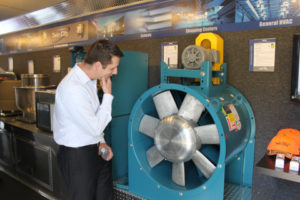Let me pencil that in: common fan scheduling issues
One of our local experts, Brandon Damas, PE, from our Dallas office delves into common fan scheduling mistakes, questions and issues he comes across and how to practice better scheduling in the future.
 I get a lot of different questions from engineers, but one of the most frequently asked questions relates to fans. Everyone knows what a fan is and what the different types of fans are but they don’t always know what type of fan to use in every application.
I get a lot of different questions from engineers, but one of the most frequently asked questions relates to fans. Everyone knows what a fan is and what the different types of fans are but they don’t always know what type of fan to use in every application.
Duly noted
One of the most prominent issues I notice is schedules with a long list of notes and accessories but not always used correctly. Here are some of the common items I see:
Note: Birdscreen/Gravity backdraft damper
Response: Not all fans have a birdscreen or even need one. Example: you wouldn’t want a birdscreen or gravity damper on a grease exhaust fan.
Note: Vibration isolation curb
Response: Covering your butt is one thing, but having this note on every fan is overkill. The biggest offender is when I see fan schedules have this note, and then also call out that each fan must be isolated on springs. Two springs is a recipe for disaster – you can get into a resonance issue and have a catastrophic failure of the system (Google Tacoma Narrows Bridge). Additionally, having this note on a fan that is mounted on rails (i.e. not a curb) or, even worse, hung from the ceiling inside (i.e. no curb needed), makes the whole schedule questionable as it gives the impression that attention to detail was not paid.
Note: DWDI, SWSI
Response: Before these terms are used, we have to understand what they mean, as I have seen them wrongly noted on multiple occasions. Double width, double inlet (DWDI) is exactly what it sounds like – basically, two fan widths with air entering on both sides. Single width, single inlet (SWSI) is air entering on one side. They are not interchangeable. A DWDI fan cannot be on a roof with one duct connection coming into the side of the fan. You would need a SWSI fan.
Moral of the story: notes are a good thing, but ensuring you get the right note for the right fan is the key.
If my calculations are correct…
A big question I get is how to meet the 90.1 fan HP calculation. The first part of the question is always “Do you need to include exhaust fans in that calculation?” The answer is yes. The HP limitations are for all fans in the system including the exhaust fans.
So, this ultimately leads to, “how do I make my fans more efficient?” Well, in general, going with larger fan wheels means your overall static efficiency will go up. There are other factors to be considered, but for most types of fans I see, the larger wheels result in smaller motors. There needs to be a balance depending on the application, but it is a good start.
Application apprehensions
The two applications that seem to garner the most questions are what type of fans should I use for labs and what type of fans should I use for general exhaust.
In regards to labs, the TVIFE is the fan to use. It is a an induced flow mixed flow exhaust fan that is intended for use in exhausting lab fumes that diminish the likelihood of contaminated air being re-entrained into the outside air intakes. The benefit of utilizing an induced flow exhaust fan is to dilute the contaminated air at the outlet, as well as increase outlet volume of the fan. This accelerates the discharge air, thus increasing plume height without a tall stack.
As for general exhaust, I see the BCV fan (utility set) or the BCRU (belt drive upblast) the most. Each has its strengths and ideal cost points, but it really depends on the airflow in relation to the static pressure to find the best solution. I would consult with your local HTS representative to have them help evaluate the right fan type for the application.
And finally I will leave you with a cheat sheet of things you can do to practice better fan scheduling.
5 things toward better fan scheduling
- Select the right fan for the right application
- Don’t have standard notes and make them specific per fan
- Schedule the maximum sound information for the fan
- Schedule the maximum brake horsepower for the fan
- Consult your local HTS representative
